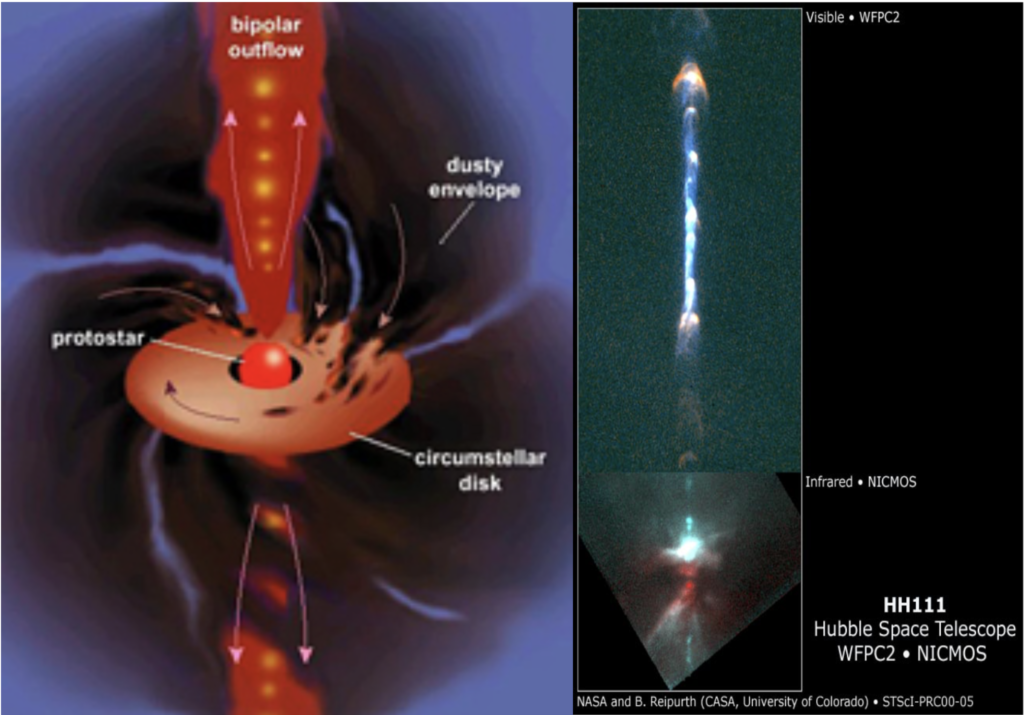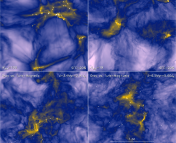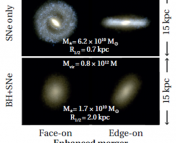Title: The role of initial magnetic field structure in the launching of protostellar jets
Authors: I. A. Gerrard, C. Federrath, R. Kuruwita
First Author’s Institution: Research School of Astronomy and Astrophysics, Australian National University, Canberra, ACT 2611, Australia
Status: Accepted in MNRAS; open access on Arxiv
Building a star is not an easy task! We now know that a number of factors come into play, such as turbulence in the surrounding material, stellar feedback, and everyone’s favorite factor – magnetic fields. Astrobites from 2015 and 2016 discuss the role of turbulence and magnetic fields in star formation, finding that turbulence both creates regions of high density that form stars while also preventing too much gas from collapsing into stars on large scales. This astrobite from 2012 also finds that magnetic fields can prevent accretion disks from forming around protostars. Clearly, getting star formation right requires fine tuning all of these factors. Today’s paper looks at the relationship between all three components to see how the orientation of a magnetic field affects the young star. Let’s step back first, though, and talk about what is meant by stellar feedback.
What is stellar feedback?
Broadly defined, stellar feedback includes all of the ways that a star feeds matter and energy back into its surroundings. We already know that stars put off light. This light transfers both energy and momentum to the surrounding gas, blowing away material while raising its temperature. What most people don’t know is that stars also eject matter. This occurs both during their formation and throughout the rest of their lives. Almost paradoxically, this ejection of material during the formation of the star is crucial for its stability, discussed more in this astrobite.
This ejection of matter comes in two forms: bipolar outflows and isotropic (spherical) winds. During the star formation phase, the bipolar outflows dominate (see Figures 1 & 2). Why are they so collimated? This is primarily due to the presence of the accretion disk, relegating the ejected material to the openings on the top and bottom. However, today’s paper also shows that the orientation of the surrounding magnetic field plays a large role in the structure of these bipolar outflows.

Right – Hubble image of one lobe of a bipolar outflow from a cluster of three stars. The stars are is enshrouded in the dusty accretion disk at the bottom, and the material is ejected with high velocity. (taken from COMPLETE Survey website)
Making stars on a computer
In order to investigate the role of magnetic fields in protostellar outflows, the grid-based, adaptive mesh refinement code FLASH is used to perform three simulations of a 1 solar mass molecular cloud: one with a uniform magnetic field, one with a partially turbulent field, and one with a fully turbulent field. Figure 2 shows what the magnetic field lines look like for each of these simulations. The magnitude of the magnetic field remains constant across all simulations, so the orientation of the field is the only variable. In the uniform case, the field lines are parallel to the rotation axis of the cloud.

As the simulation progresses, gas will begin to gravitationally collapse in certain regions of the cloud. These regions will eventually acquire enough mass to turn into sink particles. In modern simulations, sink particles are used to reduce computational cost and increase accuracy when studying star formation. Instead of trying to calculate all of the interactions that occur within a particularly dense region of gas (which will introduce numerical artifacts due to the limited resolution of the simulation), we can replace this dense region with a single sink particle of the same mass. It is important to note that, in these simulations, this is only done when it is certain that the gas is dense enough to collapse into a star. These sink particles then attract other gas in exactly the same way as the prior region of dense gas, so these sink particles can be thought of as protostars that will continue accreting material.
How does the magnetic field orientation impact this?
By comparing three different simulations in which magnetic field orientation is the only variable, the effects of this factor on star formation can be isolated. First, today’s paper considers how quickly these sink particles (protostars) grow in each of the three different cases. Figure 3 shows the growth of the sink particles as a function of time. A sink particle appears to grow the fastest in the uniform magnetic field, but many more sink particles are produced in the fully turbulent case.

Next, the role of magnetic field orientation in the launching of bipolar protostellar outflows is addressed (see Figure 4). A strong bipolar outflow is produced in both the uniform and partially turbulent simulations, though the outflow in the partially turbulent case expands slower and has larger lobes than the outflow in the uniform case. A bipolar outflow is completely absent in the fully turbulent simulation.

It is hypothesized that this is because a fully turbulent magnetic field would apply pressure to the protostar isotropically, meaning that the protostar feels the same pressure from all sides. In the uniform and partially turbulent case, there is a gradient in the magnetic pressure that could launch these outflows. Consequently, it appears that the orientation of the magnetic field can alter both how quickly stars form and how their feedback affects their surroundings. To untangle the mysteries of star formation, perhaps the degree of entanglement possessed by the magnetic field will play a crucial role!




